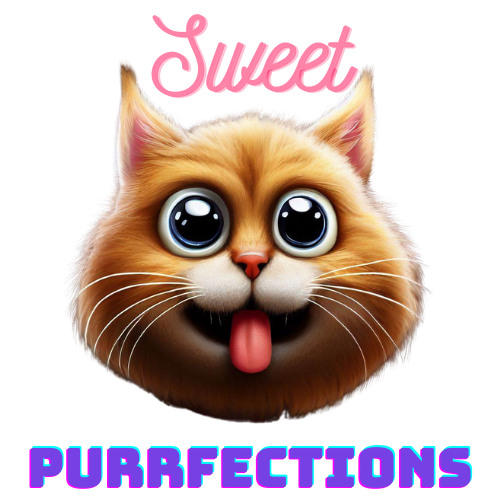You’ve scrolled past those gorgeous plant-filled interiors on Pinterest a thousand times, haven’t you? The ones with trailing pothos cascading from ceiling-hung planters and fiddle leaf figs standing tall in minimalist corners. Then you glance at your dog sprawled across the floor or your cat eyeing everything like it’s their personal jungle gym, and you keep scrolling. But what if bringing lush greenery into your home didn’t mean choosing between style and your furry family members? These surprisingly practical green decor solutions prove you can have both—without sacrificing either.
The Green Revolution Meets Real Life (With Pets)
Green isn’t just a color anymore—it’s a lifestyle statement that’s taken over home design. From sage walls to emerald velvet sofas, the color itself brings calm and connection to nature indoors. But the real trend goes deeper: actual plants, botanical prints, and organic textures that make your space feel alive. The challenge? Most of us share our homes with curious cats, enthusiastic dogs, or both. Traditional green decor advice rarely accounts for a Labrador’s wagging tail clearing an entire console table or a cat’s 2 AM zoomies that somehow always involve your most expensive planter.
The solution isn’t giving up on green design—it’s getting smarter about it. The best part? Many of these pet-proof approaches actually look MORE intentional and design-forward than traditional plant styling. When you’re forced to think creatively about placement and materials, you often end up with more interesting visual layers and unexpected focal points that generic “plant in corner” advice never delivers.
1. Vertical Gardens That Turn Walls Into Living Art
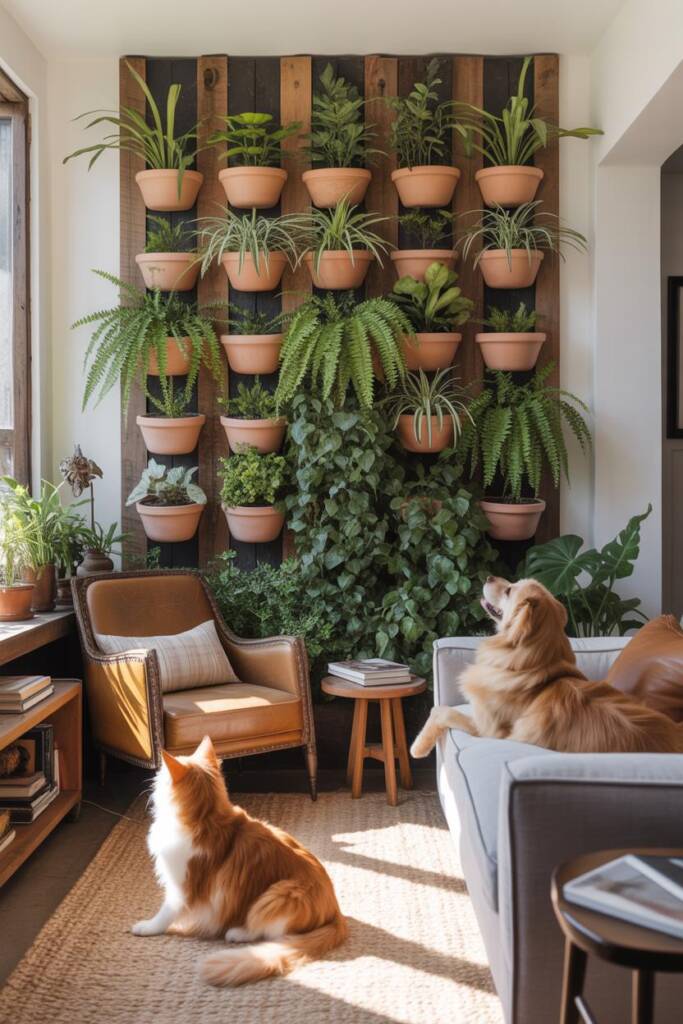
Here’s something most people miss: going vertical solves almost every pet-related plant problem while creating a stunning architectural feature. Wall-mounted modular planting systems let you build upward instead of outward, keeping your greenery completely out of reach while transforming a blank wall into a breathing masterpiece. These systems typically feature individual pockets or containers that lock into a grid framework, giving you total control over your design.
The magic happens when you mix plant heights and textures at eye level and above. Think about it—your pets live in a world from floor to about three feet high. Everything above that? Completely yours. Position a vertical garden above a console table or sofa, and suddenly you have that lush, plant-filled look without a single leaf within chewing distance. Choose pet-safe varieties like spider plants, Boston ferns, or peperomia, and even if an adventurous cat somehow reaches one, there’s no danger.
The practical benefits extend beyond pet safety. These systems make watering easier since everything’s at a comfortable height, and the vertical arrangement means better air circulation for the plants themselves. Plus, they create natural humidity which benefits both your plants and your skin during dry months. For renters, many systems use damage-free hanging strips or lean against the wall with minimal mounting, making them completely reversible when you move.
2. Moss Walls That Laugh at Curious Paws
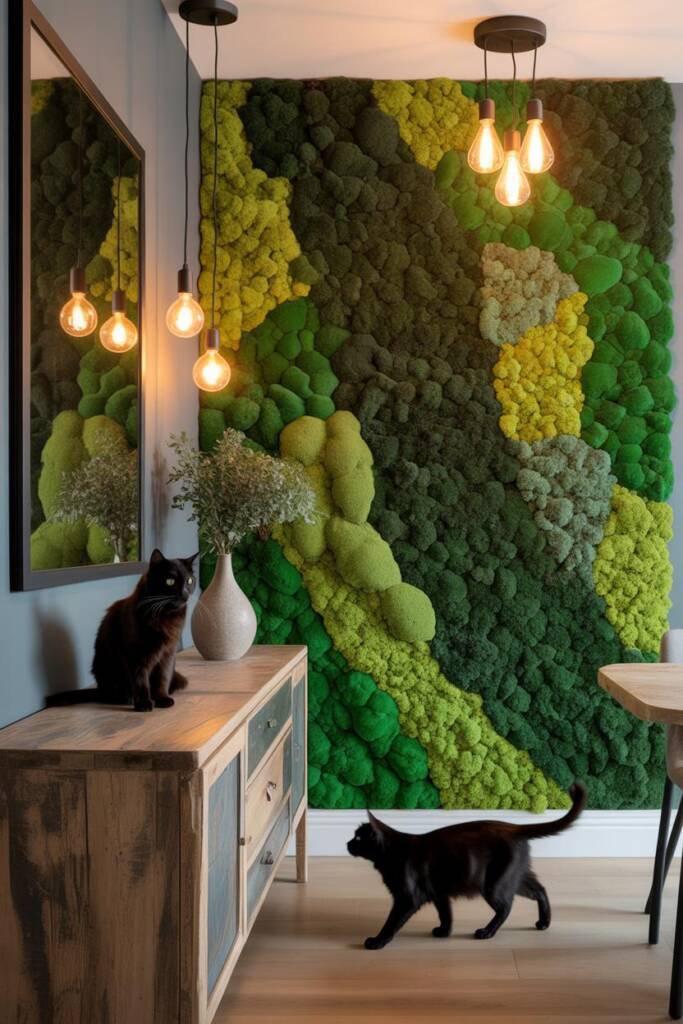
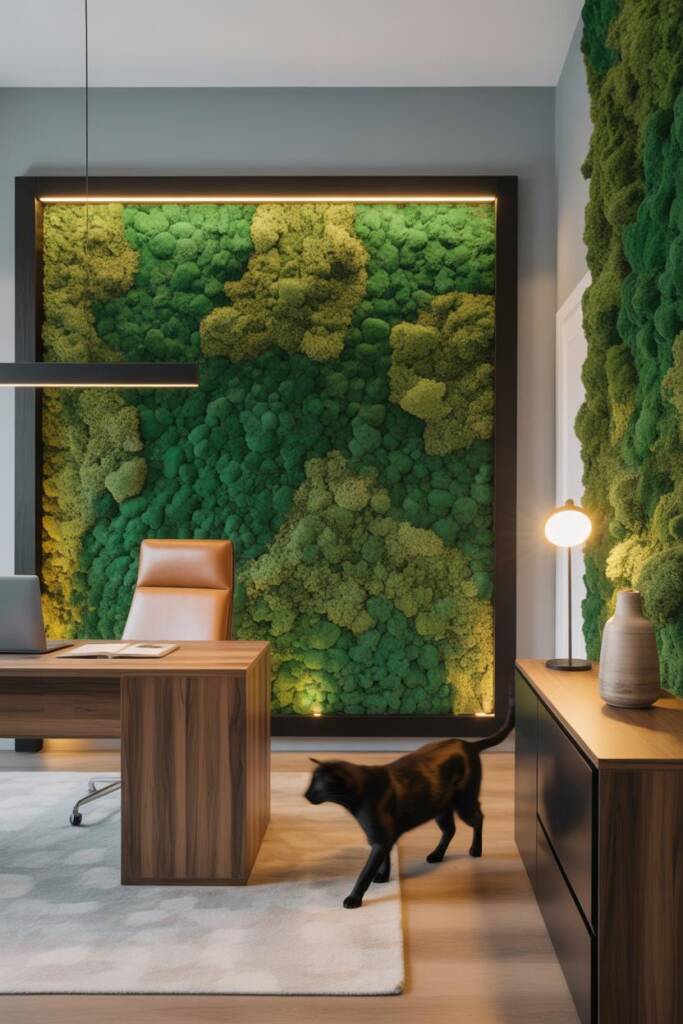
Imagine a wall covered in velvety, three-dimensional greenery that requires zero maintenance and can’t be destroyed by pets. Preserved moss walls sound too good to be true until you see one in person. These aren’t fake plants—they’re real moss that’s been preserved through a non-toxic process that maintains its soft texture and vibrant color indefinitely. No watering, no sunlight needed, and most importantly, no appeal whatsoever to pets because there’s nothing to dig, chew, or knock over.
The design impact is immediate and dramatic. A moss wall adds texture and depth that flat wall art can’t match, and the natural color variations create visual interest without any effort on your part. They’re particularly stunning in spaces where you want that biophilic connection but don’t have the natural light for real plants—think hallways, bathrooms, or north-facing rooms. The moss naturally absorbs sound too, making rooms feel quieter and more serene, which your pets will appreciate as much as you do.
Installation is surprisingly straightforward for DIY enthusiasts. Preserved moss comes in panels or tiles that attach directly to walls with adhesive, or you can create a framed moss piece that hangs like traditional artwork. The moss stays soft and pliable for years, requiring only an occasional light misting if you live in an extremely dry climate. And because it’s already preserved, there’s nothing for pets to kill even if they could reach it—which they can’t, because it’s literally part of your wall.
3. Suspended Gardens That Float Above the Chaos
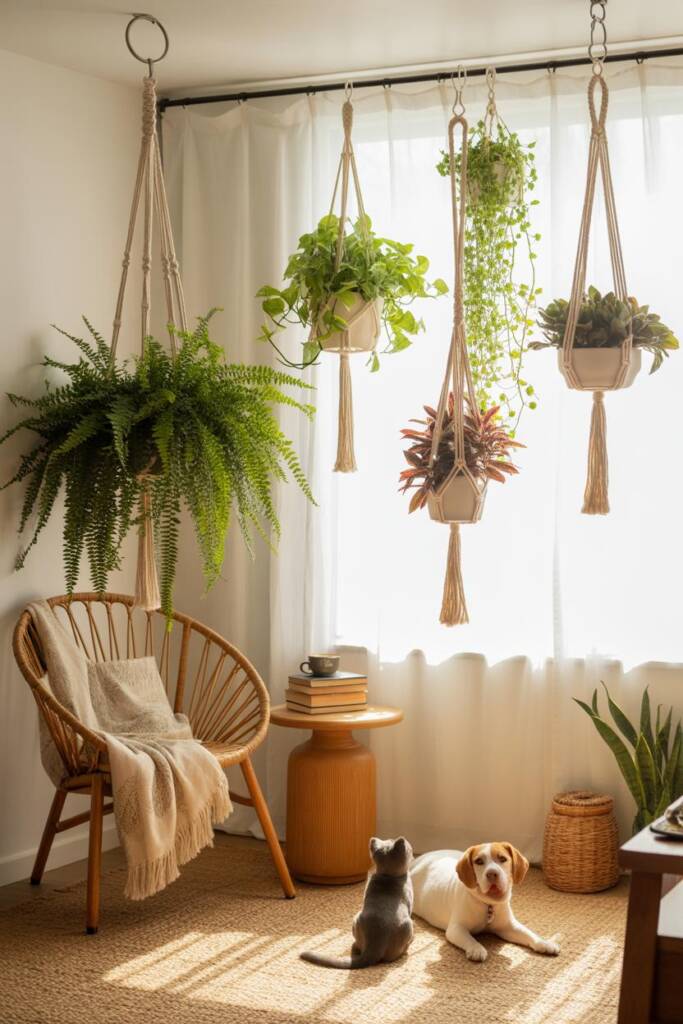
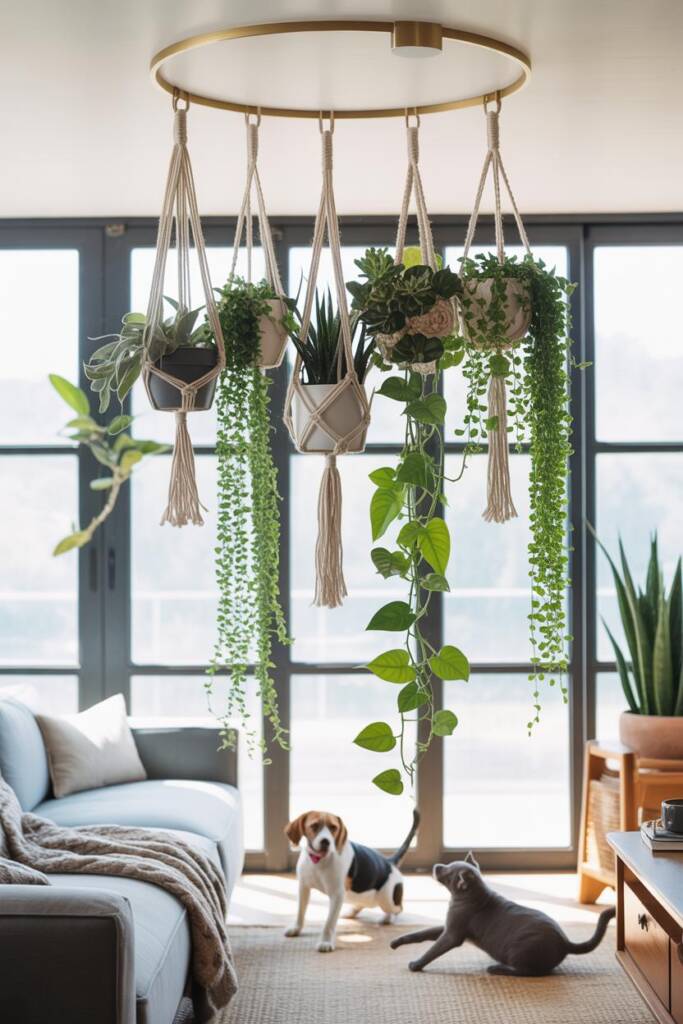
Ceiling-hung planters in macramé holders create that coveted bohemian-meets-organic look while keeping every single leaf completely out of paw’s reach. The key is using the often-ignored vertical space in your home’s upper third—the area pets never access but that draws the eye upward, making ceilings feel higher and rooms more spacious. Cluster three to five planters at varying heights near a window, and you’ve created a living chandelier that brings greenery to eye level when you’re standing, but stays safely above the danger zone.
This approach works brilliantly in front of windows where plants get the light they need while framing your view with organic shapes. Choose trailing varieties like pothos, philodendron, or string of pearls that cascade downward, creating movement and softness overhead. The trailing effect actually makes rooms feel more lush and planted than traditional floor plants because the greenery appears to fill more visual space as it drapes down through multiple sight lines.
The practical wins keep adding up. Hanging plants are easier to water if you use planters with attached drip trays—just water in place and let any excess collect in the built-in saucer. They’re perfect for small spaces where floor real estate is precious, and they draw attention away from pet toys or beds on the floor by creating interest at higher levels. Plus, there’s something undeniably satisfying about sitting on your sofa surrounded by greenery overhead, creating an almost gazebo-like feeling without your pets being able to interfere with a single leaf.
4. Living Walls Behind Glass: The Museum Approach
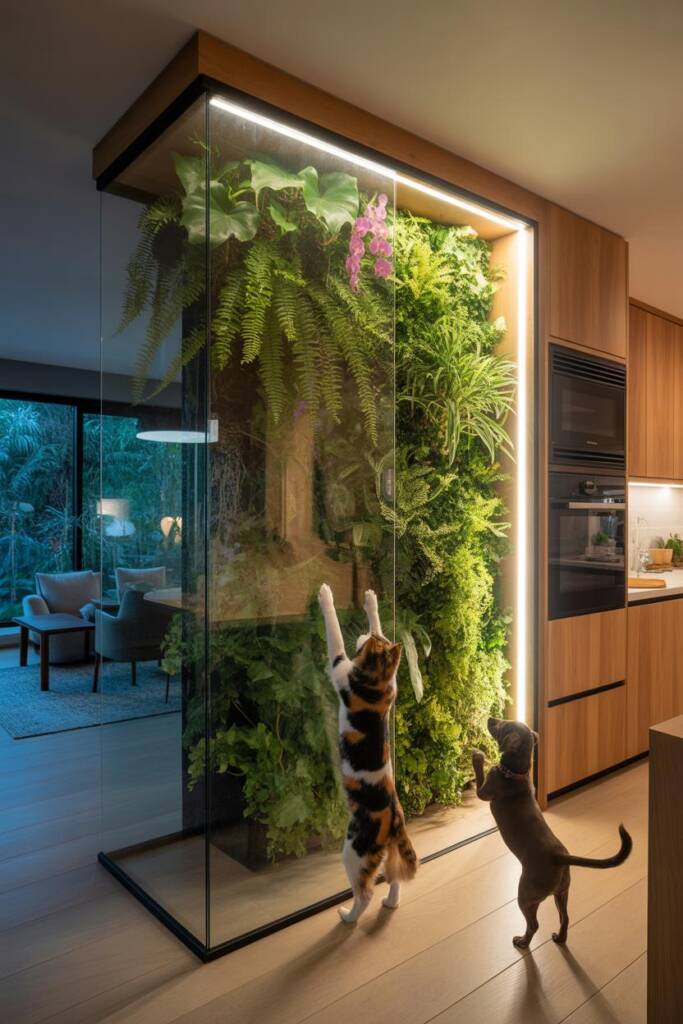
Picture this: a floor-to-ceiling planted wall that looks like it belongs in a botanical garden, completely protected behind a sleek glass panel. This architectural approach turns your plant collection into a living art installation while creating an impenetrable barrier that even the most determined pet can’t breach. The glass can be frameless for a modern look or set into elegant frames that complement traditional spaces—either way, you get the full visual impact of abundant greenery without any of the access concerns.
This solution works exceptionally well as a room divider or to create a green backdrop behind a dining table or in an entryway. The glass protection means you can include any plants you love, including varieties that might be toxic to pets, because there’s simply no way for curious mouths to reach them. The enclosed environment actually creates better growing conditions too, holding humidity and creating a mini microclimate that tropical plants absolutely thrive in.
The investment is higher than simple potted plants, but the payoff is a signature design feature that functions as both art and nature. Many homeowners incorporate these during renovations, building them into existing walls or using them to separate spaces like home offices from living areas. The glass stays remarkably clean since it’s not being touched, and the plants inside become a calming focal point that changes with the seasons as different varieties bloom or grow.
5. Anchored Greenery: When Weight Becomes a Design Feature
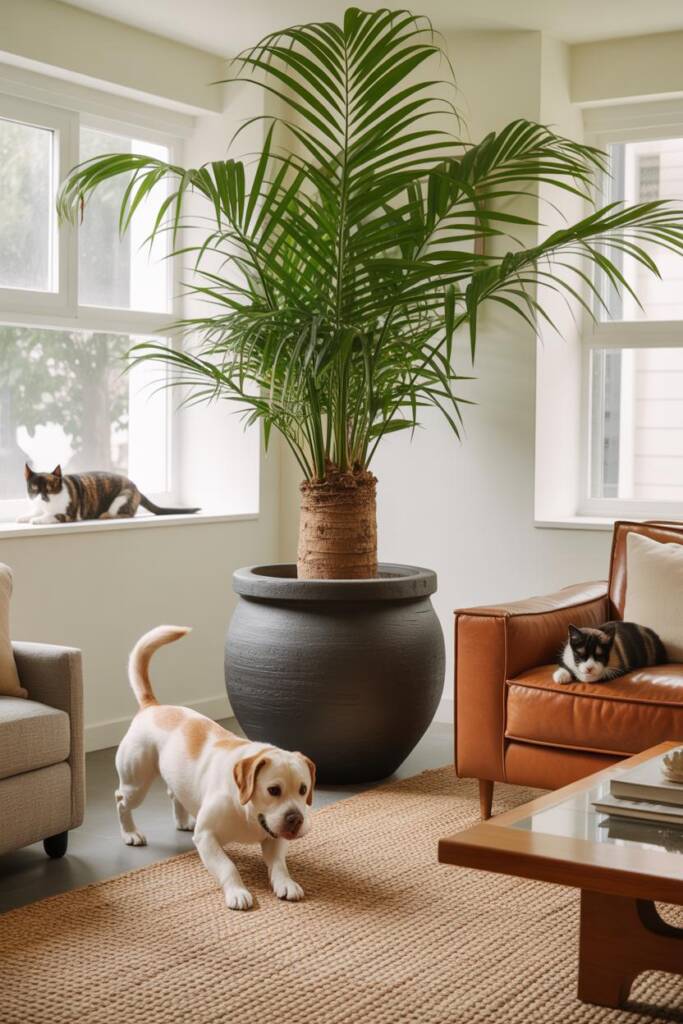
The secret to pet-proof floor plants isn’t avoiding them entirely—it’s making them so substantial that they become immovable design anchors. Large-scale trees in oversized ceramic or concrete planters weighing 30+ pounds create dramatic focal points that won’t budge no matter how enthusiastic your golden retriever gets during playtime. Think fiddle leaf figs, rubber plants, or dracaena trees in planters that are as much sculpture as container, with wide bases that provide stability while making a serious style statement.
The psychology here is brilliant: pets instinctively understand that some objects are fixed parts of their environment, like furniture. When a planter is substantial enough, they mentally categorize it the same way they do your sofa—something to navigate around rather than investigate. Choose a planter that’s at least 16-20 inches in diameter with thick walls, and position your tree in a corner or against a wall where it becomes part of the room’s architecture rather than something in the middle of traffic flow.
Pet-safe tree options are more abundant than you’d think. Parlor palms, ponytail palms, areca palms, and money trees are all non-toxic and create that upward growth that draws eyes toward the ceiling. The leaves are typically high enough that even jumping cats won’t bother with them once the novelty wears off. And here’s the bonus: these substantial plants are easier to care for because their root systems are established and forgiving. You’re not dealing with finicky small plants that die if you miss a watering—these are statement pieces that anchor your entire color scheme and design concept.
6. Greenhouse Windows and Built-In Planter Nooks
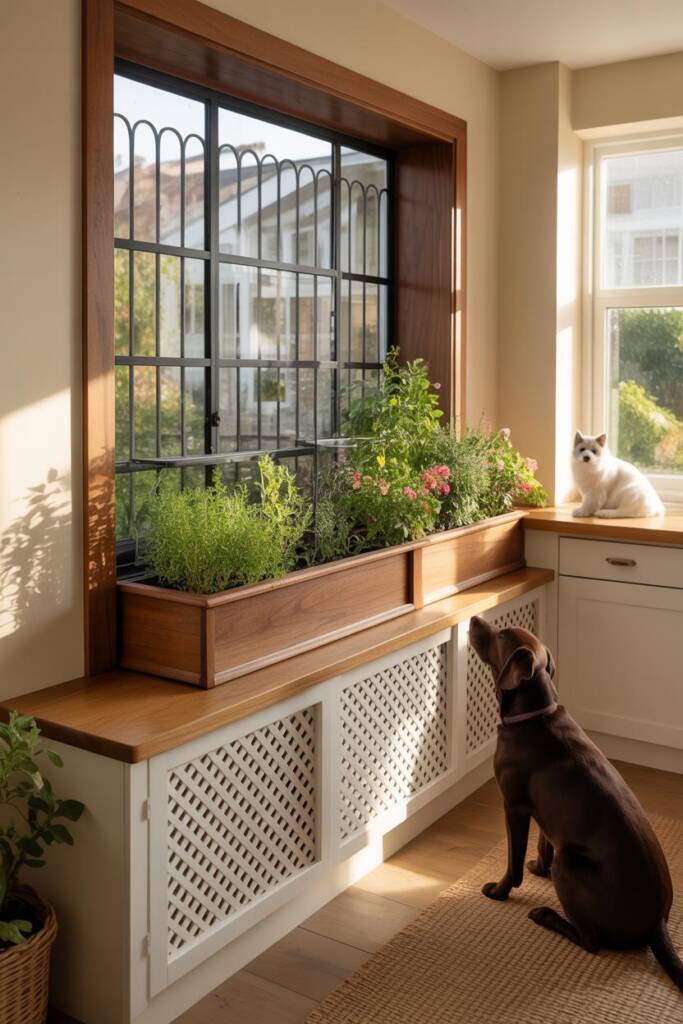
Architectural solutions offer the most permanent and elegant answer to the pet-versus-plants dilemma. Built-in planter boxes with low decorative railings, mesh screens, or even clear acrylic barriers create designated green zones that are clearly off-limits while remaining fully visible and beautiful.
Picture a window seat with a planter box built into the back, separated by a low wrought-iron rail that matches your curtain rods. Or a kitchen window extended into a garden box that juts outward with glass on three sides, creating a miniature greenhouse where herbs and flowers thrive completely separate from the main living space.
These built-ins work because they establish clear boundaries that pets naturally respect—especially when combined with consistent training. A decorative screen doesn’t have to be fortress-like to be effective; even a simple wooden lattice panel painted to match your trim creates a visual and physical separation that most pets won’t challenge. The key is making the barrier attractive enough that it enhances rather than detracts from the design, becoming an intentional part of the room’s character.
For renters or those not ready for permanent construction, furniture-based solutions offer similar benefits. A narrow console table placed in front of a low windowsill creates a raised planting platform that’s difficult for dogs to reach and uninteresting to cats because there’s no easy jumping path. Top it with a row of matching planters for a cohesive look that appears professionally designed. The furniture acts as both display and barrier, and you can take it with you when you move.
7. Contained Ecosystems: Terrariums as Functional Art
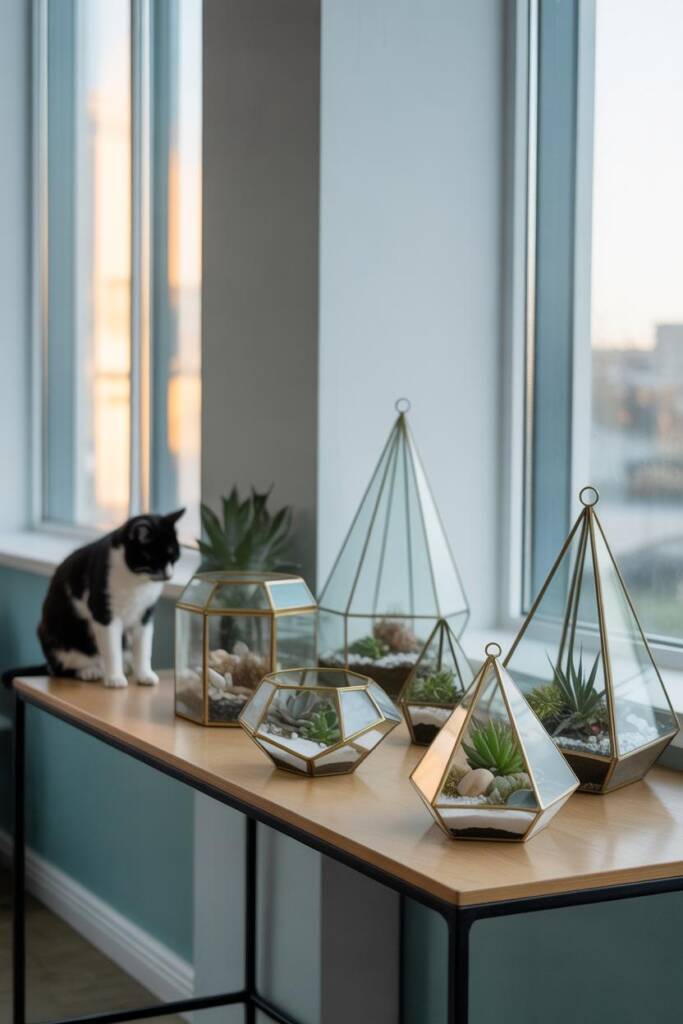
Terrariums and glass-enclosed gardens transform plant care into jewelry-like displays that double as conversation pieces. These self-contained environments range from desktop-sized glass globes to substantial bell jars covering entire tabletop gardens, and they’re completely pet-proof by design. The glass enclosure creates a barrier that’s both elegant and absolute—your pets can look but definitely can’t touch, and the plants inside thrive in their own humid, protected world.
The aesthetic appeal goes beyond simple protection. A well-designed terrarium becomes a living sculpture that changes throughout the day as light shifts and creates different shadows and highlights through the glass. Group several varying sizes on a coffee table or sideboard, and you’ve created a collected, curated look that feels intentional and sophisticated. Fill them with air plants, succulents, or moisture-loving ferns depending on whether you choose open or closed designs, and suddenly you’re growing plants that would otherwise be impossible in a pet-filled home.
Modern terrariums come in geometric shapes that fit contemporary spaces beautifully—hexagonal, pyramid, or dome designs in black metal frames that look like something from a design magazine. They’re perfect for showcasing special plants or creating themed mini-landscapes with decorative rocks, driftwood, and moss. And because they’re elevated on tables or shelves rather than on the floor, they occupy that pet-free zone while adding greenery at exactly the right height for humans to enjoy up close.
8. The Faux Revolution: When Artificial Looks Exceptional
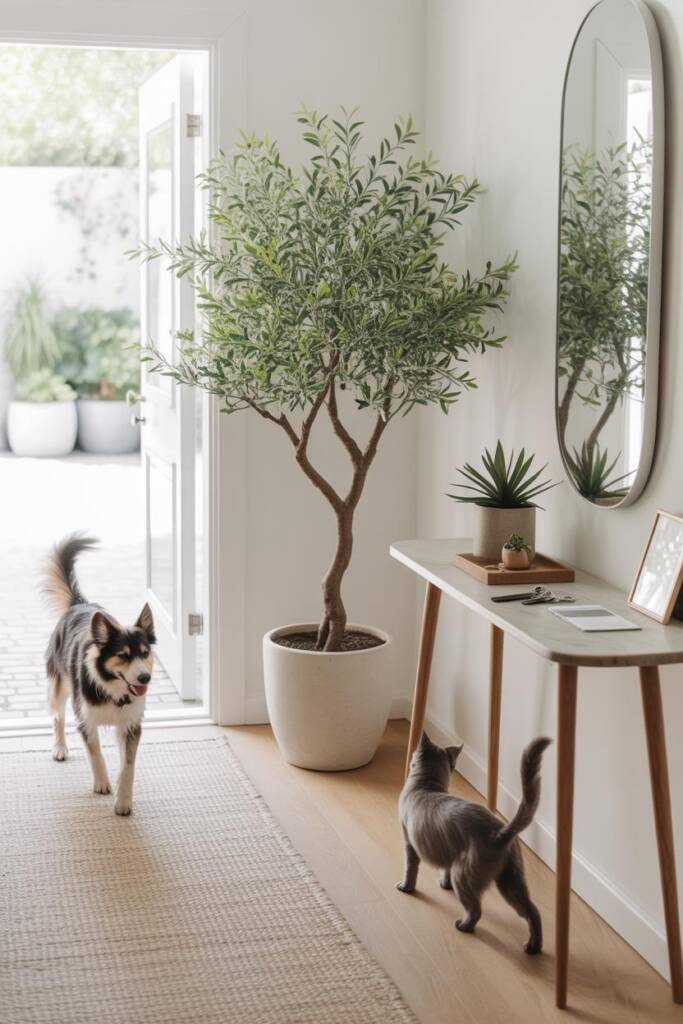
High-quality artificial plants have become so realistic that they deserve serious consideration, especially for pet owners who want zero-risk greenery in their homes. We’re not talking about dusty plastic monstrosities from decades past—today’s faux options use silk, preserved natural stems, and advanced manufacturing that replicates everything from leaf veining to natural color variations. A premium faux olive tree or fiddle leaf fig can pass close inspection and never drops leaves, needs watering, or poses any toxicity concerns whatsoever.
The strategic use of artificial plants means you can place greenery anywhere—dark corners, windowless bathrooms, beside heat vents, or in direct pet pathways—without a single care consideration. That awkward corner that gets no natural light? Perfect for a dramatic faux monstera. The entryway where your dog’s tail clears everything? A artificial eucalyptus arrangement in a heavy vase creates the look without the breakage risk. You get to style your space exactly as those Pinterest photos show without any of the maintenance or pet-safety compromises.
Mix artificial with real plants strategically, and guests often can’t identify which is which. Use faux for difficult spots and real plants in your protected zones, creating layers of greenery throughout your home that all read as living and lush. The best artificial plants are also UV-resistant for outdoor spaces, opening up even more design possibilities for covered patios where pets spend time. And there’s something wonderfully freeing about travel-ready homes where you never worry about watering schedules or coming home to destroyed plants.
Shopping List to Make These Ideas Work
Everything you need to start creating your pet-proof green oasis
- Heavy Ceramic or Concrete Planters (16″+ diameter) – The foundation of stable floor plants, these substantial containers provide weight and tip resistance while serving as sculptural elements themselves. Look for options with drainage holes and wide bases that distribute weight evenly.
- Wall-Mounted Modular Planting Systems – Vertical garden frameworks that attach securely to walls and hold individual plant containers at safe heights. Choose systems with built-in irrigation channels for easier maintenance and consistent watering across multiple plants.
- Preserved Moss Panels or Tiles – Ready-to-install moss sections that attach directly to walls with adhesive backing. These require zero maintenance while providing authentic texture and color that lasts for years without fading or drying out.
- Ceiling Hook Kits with Swivel Mounts – Heavy-duty hardware designed specifically for hanging plants, rated for 15-30 pounds each. Swivel mounts prevent twisting and make it easier to rotate plants for even light exposure.
- Glass Terrariums in Various Sizes – Self-contained planting vessels that protect plants while creating display-worthy focal points. Geometric designs in metal frames offer the most contemporary look, while classic bell jars suit traditional spaces beautifully.
Why Sweet Purrfections Gets Your Design Dilemma
Creating a home that’s both stylish and pet-friendly isn’t about compromise—it’s about getting creative with solutions that work harder and look better than standard approaches.
At Sweet Purrfections, we understand that your pets are family, and your home should reflect both your love for them and your personal style. Whether you’re drawn to dramatic vertical gardens, serene moss walls, or the flexibility of well-chosen artificial greenery, there’s always a way to bring your Pinterest-inspired vision to life without sacrificing the joy of sharing your space with furry companions. Your home can be that beautiful, plant-filled sanctuary you’ve been dreaming about—it just takes the right approach.
Meet Sean, a fintech whiz with a penchant for pet purrs and blockchain buzz. After a decade of fintech feats, Sean’s tech talents leaped from ledger lines to litter lines, driven by a passion for pets and a vision for a more connected pet care community. With three critter companions as co-pilots, Sean launched this blog to share a treasury of pet-friendly tech tips and tales.
